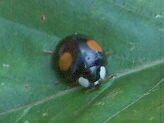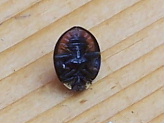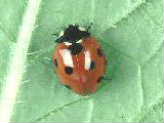Photograph © Paul Pratt of Canadian aggregation
Harmonia axyridis (Pallas) in Britain
The many-named ladybird! Multicoloured (multicolored), multivariate, southern, Japanese, Asian, Halloween, harlequin or pumpkin ladybird (ladybug, ladybeetle); la coccinelle asiatique, veelkeurig Aziatisch lieveheersbeestje, Asiatischer Marienkafer.
|
Photograph © Paul Pratt of Canadian aggregation |
| PROBLEM | IN BRITAIN | CURE? |
| IDENTIFICATION | PICTURES | LINKS |
| DISPERSAL | STOP PRESS | MAPS |
History
This northern, east Asian ladybird was imported to the SE United States about twenty-five years ago: it established successfully, extending north into Canada and through the rest of the USA. It is now the most abundant ladybird to the detriment of many native species. Despite the American experience, the animal was also released into Italy and elsewhere in Europe. It has now established and become common in Germany (2000), Holland (2002) and Belgium (2002). Numbers in The Netherlands and Belgium increased greatly in June-July 2004 (despite it being a 'bad' year for aphids and ladybirds) so we might expect them to fly towards the British Isles...... And they did, see
H. axyridis is a very potent aphid-eater (aphidophage)
and thus potentially useful in biological control of pest species. Unfortunately
it also has a very large prey-range. Its voracity allows it to eat all aphids,
out-competing native ladybirds whose populations decline by starvation. Some
formerly common species in Canada are now rare. Furthermore, when it runs out of
aphids, it starts eating other invertebrates - other ladybird species,
hoverflies, lacewings, butterflies &c. These other species, many of
them beneficial, are put at risk. This has happened in N. America and will
probably happen in Europe. These problems on a continental scale may be
magnified on a small island.
The first British record was by Ian Wright who found a single specimen in
the grounds of the White Lion at Sible Hedingham, north Essex on 19th
September 2004. On 7th October, Diane Andrews found another example in
Tottenham Cemetery, north London. Both specimens were melanic - black with two
or four red patches. Initially these isolated finds left hope that the beetle
would not establish in Britain. However, others have been seen in south London
and elsewhere and Chris Gibson unearthed a ladybird taken in a moth trap on the
night of 21-22 August. Tony Irwin had found a larva in Norwich during
July. This and later finds will be logged in stop
press.
It was at first hoped that these were isolated individuals
blown across the sea and that if collected there would be no immediate
establishment. No such luck! In the longer term there is a strong
chance that the ladybird will prosper. If the insect's natural predators
and pathogens are present then numbers may eventually be stabilised by natural
processes - in the beetle's Asian environment it is not a pest because its
population is controlled by the predators and bacteria that have evolved with
it. It may, however, be necessary to import parasitoids; bacterial treatments
may also be developed.
In the meantime, please take all multicoloured ladybirds that you find and send them to an entomologist: Michael Majerus Dept of Genetics University of Cambridge CB2 3EH will welcome any number of specimens. If more convenient, they may be sent to me or a local entomologist (at your natural history society or museum, perhaps). Ladybirds travel well by post if securely packed in a small, strong container such as a photographic film tube. Please check the identification notes below: there is no need to send obviously harmless animals and there is no need to kill any ladybird!
See also images below. Because the species is so variable there might be confusion in its identification.
1 The first, critical feature is that it is large (by ladybird standards): 6-8 mms long which is the length, or more, of our native 7-spot ladybird. Thus the smaller species which may have similar patterns should not cause confusion.
2 It may be red or 'orange' (pale red) with 0-19 black spots (which may vary in size) or it may be black, usually with two to eight red patches but some bizarre patterns not found on any other British ladybird..
3 It has a single triangular white mark on its head. It always has white patches down the side of the forebody: in red ladybirds the forebody pattern is M-shaped.
4 Melanic (mainly black) ladybirds: these are only very rarely seen amongst our native large ladybirds so a large black ladybird is likely to be H. axyridis. Underneath: the legs are brownish and the hind rim of the underside is quite red. Unlike most melanics, these retain the wide, white sides of the forebody (pronotum).
5 Its whole body is rounder than most British ladybirds.
6 At this size, the only native species which might be confused are the 7-spot (H. axyridis does not have this pattern), scarce 7-spot (these are always found near wood ants nests, H. axyridis is not), eyed ladybird (black legged), cream-spot (has "spotty" forebody not the large "pseudo-eyes" of H. axyridis), bryony (this always has a red forebody - no white patches). Please check the images below.
H. axyridis - a rogues gallery of London haxy is also available!
 |
Tottenham (Diane Andrews). Note the small white mark on the head, the broad white sides to the forebody and the partly red underside on the abdomen. |  |
 |
Ohio ladybirds. Photograph © Stephen
Rigden |
 |
 |
L: Photograph © Washington
State University
R: Chiswick 2005 © Mick Massie |
 |
 |
Left: taken at light on night of 21-22 August by Chris
Gibson in Dovercourt, Essex in a moth light trap. Photograph © C. Gibson Right: specimens from Clapham, Chelsea and Kensington; note the many dark variants (including bull's-eye pattern - click picture to enlarge) compared to the Canadian group |
 |
 |
The larvae of Harmonia species
are distinctive, being black with red-orange marks in a line along each
side of the middle five abdominal segments. Left, Photograph © Antoon
Loomans, Plant Protection Service Wageningen, The
Netherlands. Right, from Clapham Common |
 |
 |
The pupae (L) are large but quite variable in colouring.
Photograph © Antoon Loomans Specimens (R), from Chelsea, show variation in size and number of red markings; most are very dark. HOWEVER larvae and pupae of the cream-streaked ladybird are very similar. |
 |
 |
The exuvia are not really helpful but tend to be more upright than other large ladybirds: 'spines' are visible at the attached end. | High quality Coolpix photos at: Pre-pupa Pupa Exuvium |
Image links:
A disparate pair
at Cambridge: Genetics.
Cambridge
Includes larva: nev.nl/nieuws/axyridis/
Life
cycle: edis.ifas.ufl.edu
NOT H. axyridis - please do not collect or destroy these harmless and beneficial ladybirds!
 |
7-spot ladybird Has very constant spot pattern which does not resemble any H. axyridis. Always has black legs. The white patches on the forebody do not extend all along the sides. |
|
 |
Eyed ladybird There are variants with fewer spots and no 'eyes' but always with black legs. The forebody has a very different pattern from H. axyridis. |
|
 |
Cream-streaked ladybird Has from 0-16 spots but always many small black spots on the pronotum (forebody). See also. |
 |
 |
Bryony ladybird (left) No white or black patches on the pronotum. Photograph © Ian Menzies Kidney spot ladybird (right) No white patches on the pronotum |
 |
National Harmonia axyridis survey:
http://www.harlequin-survey.org/
1995 Canadian survey - matters have not improved:
LADY BEETLE SURVEY
Swarms in
Ontario:
http://www.ojibway.ca/lady.htm
House
invasions in Kentucky:
http://www.uky.edu/Agriculture/Entomology/entfacts/trees/ef416.htm
General
problems in USA:
http://www.nysaes.cornell.edu/ent/biocontrol/predators/harmonia.html
Belgian
forum on invasive species:
http://www.biodiversity.be/bbpf/forum/invasion/species/harmonia.html
Dutch
news:
http://www.nev.nl/nieuws/axyridis/Gezocht.html
A
comprehensive study (2003) on the biology, uses and abuses of H.
axyridis:
http://www.insectscience.org/3.32/Koch_JIS_3_32_2003.pdf
Ladybirds may disperse under their own steam or be transported by
human agencies (anthropochory).
When
ladybirds run out of food they will fly in search of more aphids (or anything
else they can eat). This can lead to large aggregations such as those on the
Belgian coast in July 2004. It is quite likely that some of these flew over the
sea to England as suggested by the finding of individuals at coastal
sites. However, we should not assume that all aggregations are for migration.
Many ladybirds aggregate to overwinter and at other times, as food runs out,
they move in search of food and thus aggregate by accident!
Many insects are transported by humans in
various ways. They may hitch a ride on boats or trains (several finds have been
near the continental rail lines to Waterloo and Clapham Junction) or they may
come over on flowers (the pupa on cut supermarket flowers in Newmarket), plants
(the beetle has been found near the grounds of the Chelsea Flower Show) or food
(many of the south London observations are near the New Covent Garden fruit and
vegetable market).
|
London
- Inner
London - Essex
- These will be up-dated regularly
and cached on a separate page. Created with DMap |
|
London observations to 11th September, 2006 |
|
|
|
|
|
Essex and surrounding area:
observations to 26th August 2005 |
|
|
11/9/06: Now seen in Humberside and Merseyside. In London,
spreading further out in Enfield and other suburban, semi-natural areas although
not yet in huge numbers: the sunny weather of early September may change this
....
1/8/06: National extension of range including South
Lincolnshire, Northamptonshire, Nottinghamshire, Leicestershire and Rutland
although Bill Grange reports few sighting in Derby. It appears that
singletons have taken flight and dispersed, much as in London last year.
29/6/06: slight extensions of range (Stanmore, Edmonton, Kew Gardens,
Hampton) with first Hillingdon record (Lesley Sargeant): all London
boroughs now have haxy.
26/4/06: relatively few compared to native
species during April but large egg patches observed on tree trunks in Chiswick
and elsewhere.
15/3/2006: Haxy
remained active until the end of the year and then, largely, 'disappeared' -
there were a few reports (e.g. in Brixton) of them flying around houses
but no large numbers. Two imagines and a modest number of exuvia in north
Barking demonstrate that the earlier gaps were due to lack of recorders rather
than ladybirds! The only London Borough without records now is Hillingdon.
Few 2005 records received from Essex.
11/12/05: Still active in S/W
London - some
considerations. UK
distribution map shows filling up of SE England.
4/12/05: records
from Enfield and Bromley: only Barking, Hounslow and Kingston of London Boroughs
without reports. Despite heavy frosts haxy still visible and emerging from pupae
(David Element, Collier's Wood 2nd December) with sightings in strange places:
Albert Hall and Kew Herbarium but fairly few entering houses, yet ....
National map has been up-dated with sightings up to Northamptonshire and
Leicestershire.
5/11/05: George Washington reports observations
from Walthamstow Queen's Road Cemetery. Still much in evidence in the centre of
Derby.
31/10/05: First record for Harrow, David Element finding many,
including larvae, in Merton: only Enfield, Barking & Dagenham, Bromley,
Kingston and Hillingdon now devoid of records. In the latest batches
of observations no spotless or weakly spotted forms found. Retrospective
reports of haxy being found in Tower Hamlets Cemetery. Meanwhile, back
in Derby,
considerable numbers being seen including aggregations on the cathedral and a
report of 'thousands' entering a house in Darley Abbey (showing how they got
their name of Hallowe'en beetle). Nationally, records from Staffordshire,
West Midlands and Gloucestershire. No large numbers from Essex although
there has been a surge of reports of individuals during October. Belgian reports
suggest further dispersal inland, to the Ardennes. Many specimens are now quite
small.
21/10/05:
Larvae still being observed although most have pupated or emerged. Only six London
Boroughs without the beast. Increasing numbers of inland reports from Essex,
Suffolk and elsewhere in the SE but fewer from the rest of UK. As last autumn,
many of the latest are very dark as in Suffolk
specimens collected by Diane Andrews.
8/10/05: Records from Watford,
Streatham and Greenwich confirm the encirclement of London and spread into the
suburbs.
Recent activity in NE Essex and reports of large numbers
from Ramsgate: are these flying over from the continent? Certainly they are
flying all over London.
6/10/05:
North London now pretty well covered from Greenford to Wood Green.
Interesting observation from Peter Pearson at Felixstowe where a large colony
found on nettles - most reports are from trees.
29/9/05: More reports from N. London and some (Gavin
Hawgood) from Norwood: as south east as we get ... gallery of
London patterns.
21/9/05: Jerry Bowdrey reports
first recent sightings from Colchester - on Buddleja. Widespread reports
of specimens taken at light.
20/9/05: Reports from Finchley, Alexandra
Park and the 134 'bus to Kentish Town! Mainly larvae but there are now many
pupae - Judith Lane has collected 70 at Harold Wood.
14/9/05: Large
colonies in Battersea, Bermondsey, Rotherhithe, West Ham and Hackney. Elsewhere
it is almost impossible to find a lime tree without larvae! Several sightings of
them eating pupae of 2-spot and other ladybirds. More
details and pictures......
9/9/05: Mick Massie reports 'dozens' of
imagines and some larvae from lime trees in Chiswick.
7/9/05: Records
now from East London (Bow, Limehouse and Harold Wood). Still none along the
Thames or in SE London.
21/8/05: All life stages except eggs found
across inner London: Balham to Shepherd's Bush to Holloway, mostly on lime,
sycamore and Buddleja. First sighting in a London Park (Kensington
Gardens).
30/7/05: Few recordings nationally except for Derby where Bill Grange continues
to find occasional specimens including what looked like the first British
sighting of the nominate form but Michael Majerus considers it an unusual
succinea.
28/6/05: Henri Gassend collected pupae in Wandsworth a few
weeks ago from which two ladybirds emerged on 22nd. These soon started mating
and eggs were produced today.
20/4/05: New records from the national
survey: mainly in SW postal districts but spreading further into Southwark with
a sighting in Soho and the first observation from the Essex Estuary at Grays
(closer to the Southend Arterial than the Thames!).
15/3/05: Second
Derby specimen: Bill Grange, curator, found one walking around a sink in the
Museum - the sink had earlier been used to water a supermarket pot plant.
Possibly the ladybird is still being imported?
1/3/05: In the coldest
sustained spell of the winter. Latest list of sightings include
observations from December and January.
20/2/05: Individual active in
Southwark garden sent to Andrew Halstead at RHS; reports of many active
ladybirds in Great Yarmouth.
2/2/2005:
Mick Massie finds healthy but inactive ladybird on sycamore tree in Chiswick.
The first London observation since November - after a very mild
winter.
23/11//04: More records from coastal areas with definite
clusters around Canterbury, Colchester and Ipswich. Largest numbers still found
in SW London. The London distribution extends with records from Hammersmith,
Purley, Camberwell, Sydenham, Redbridge and Harlow. Nigel Cuming has reared a
parasitoid (probably Dinocampus coccinellae) from one Essex
specimen.
12/11/04: Temperatures falling throughout Britain (1C in
Leeds yesterday) - will H. axyridis survive the British
winter?
9/11/04: Latest listing from Michael Majerus includes
one from Burnley, Lancashire. Increasing numbers from coastal Kent, one from
Hampshire.
7/11/04: Continued sightings from London and Colchester
area. Many (most?) British sightings continue to be darker forms. Notably
American populations tend to be mainly red, melanics being quite rare (compare
and contrast Canadian photo at the head of this page and London
sample).
2/11/04: "First" sighting date pushed back to
July. Tony Irwin (Norwich Museum) has photo of larva which was "running
(in a manic fashion) around the rim of a flowerpot in our garden...". He
also reports hundreds of adults in Great Yarmouth Cemetery since the middle of
October .....
31/10/04: Diane Andrews collects pre-emergent pupae from
sycamore on railway embankment east of Alexandra Park.
30/10/04:
Antoon Loomans notes ladybirds still active in The Netherlands and that on
27/28th there were large flights and aggregations in the south of the country
(thousands all over Tilburg). More flights to Britain?
27/10/04: Jerry
Bowdrey has cluster of finds in Colchester including one in spider's web in own
home.
26/10/04: Latest Cambridge web-page has find north of Derby.
Further reports from SW. London and Kent
23/10/04: Jerry Bowdrey has
more finds from Colchester - multiple and 'new' generation.
22/10/04:
Another coastal find - indoors at Wivenhoe: exhibited at Colchester
Museum.
21/10/04: Michael Majerus up-date confirms more reports from
Suffolk and Sussex.
20/10/04: More findings including larvae, pupae
and recently emerged adults in south London (Clapham Common on lime and sycamore
trees) but also the first multiple group north of the Thames on Chelsea
Embankment. Two on garden ivy in South Kensington.
14/10/04: Confirmed
sightings from Kent and Suffolk and one emerging from pupa on supermarket
flowers in Newmarket. Several south London sightings close to New Covent Garden
Market.
11/10/04: Chris Gibson recognises ladybird trapped at
ultra-violet light in Dovercourt on 21-22 August.
9/10/04:
Michael Majerus confirms breeding in Battersea; multiple beetles in
Wandsworth.
8/10/04: Unconfirmed reports from Battersea, S London and
Canterbury, Kent.
7/10/04: Diane Andrews finds solitary melanic on
lime tree in Tottenham Cemetery.
19/9/04: Ian Wright makes first
report of solitary melanic from garden of White Lion, Sible Hedingham
Thanks
To Michael Majerus and Peter Brown for keeping us up-dated on the British status and Antoon Loomans for helpful information on distribution and activity in NW Europe. Especially to all the people who have been looking out for this animal and helping to monitor its progress. Boundary parameters of some maps produced by Colin Plant and Peter Harvey.
CREATED 8.x.2004
LAST MODIFIED
11.ix.2006